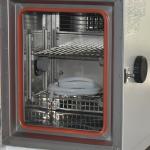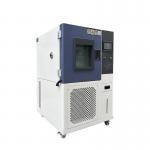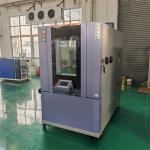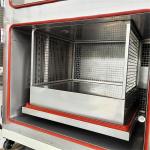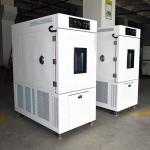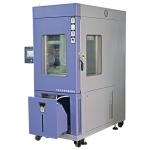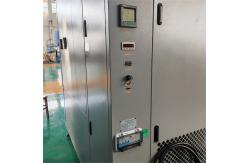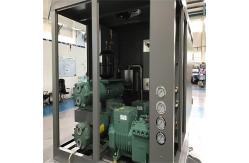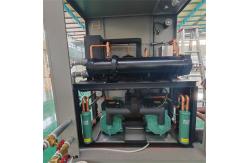In the aerospace and defense sectors, where the margin for error is
virtually nonexistent, the 600L Large Volume Environmental
Simulation Chamber emerges as a cornerstone of product testing and
validation. This advanced piece of equipment is engineered to
subject aerospace and defense components, systems, and even
small-scale prototypes to the most exacting temperature and
humidity conditions, ensuring their unwavering performance and
reliability in the face of the harshest operational environments. This state-of-the-art chamber, with a generous 600L capacity, is
dedicated to replicating the extreme temperature and humidity
fluctuations that aerospace and defense equipment will encounter
throughout their lifecycle. It serves as an indispensable tool for
aerospace manufacturers, defense contractors, research
institutions, and military testing facilities. The primary
objective is to conduct comprehensive environmental stress testing,
thereby identifying any potential weaknesses or vulnerabilities in
the design, materials, or manufacturing processes of critical
components such as avionics systems, missile guidance systems,
satellite components, and military vehicle electronics. By
subjecting these items to a wide range of temperature and humidity
scenarios, from the frigid cold of high-altitude flight to the
sweltering heat and humidity of tropical battlefields, engineers
and scientists can optimize designs, enhance durability, and
ultimately safeguard mission success and personnel safety. - Spacious and Robust Construction
- The chamber is constructed with a heavy-duty, high-strength alloy
framework that is specifically engineered to withstand the rigors
of both the testing process and the extreme conditions it
simulates. The exterior shell is fabricated from
corrosion-resistant materials, ensuring long-term durability and
protection against the elements. The interior is lined with a
thermally conductive and chemically inert material that promotes
uniform temperature distribution and minimizes any potential
interference with the tested samples. The door is a
precision-engineered component, featuring a multi-point locking
system and a high-quality sealing gasket. This ensures an airtight
and hermetic seal, preventing any leakage of conditioned air and
maintaining the integrity of the simulated environment. A large,
reinforced viewing window, made of tempered and anti-fog glass,
allows for real-time visual inspection of the testing process
without compromising the chamber's environmental control.
- Precision Temperature and Humidity Control Systems
- Temperature Control: Capable of maintaining an extensive
temperature range, from -70°C to +150°C, with an astonishing
accuracy of ±0.5°C. This is achieved through a combination of
advanced refrigeration technologies, including cascade
refrigeration for ultra-low temperature capabilities, and
high-power heating elements. The control system is a marvel of
engineering, incorporating a sophisticated feedback loop with
multiple strategically placed temperature sensors throughout the
chamber. This not only ensures uniform temperature distribution but
also enables rapid and precise temperature transitions. The
user-friendly control panel permits the programming of complex
temperature profiles, including rapid temperature ramps, extended
dwell times at specific temperatures, and intricate cycling
sequences, all of which are essential for replicating the dynamic
temperature changes experienced in aerospace and defense
applications.
- Humidity Control: The humidity control system is equally
impressive, with the ability to achieve and maintain humidity
levels ranging from 5% to 95% RH (Relative Humidity), with an
accuracy of ±3% RH. It employs a combination of steam injection
humidifiers and desiccant dehumidifiers, integrated with a
carefully designed air circulation system. The chamber is equipped
with high-precision humidity sensors that continuously monitor the
internal humidity. The control system then makes real-time
adjustments to the humidification or dehumidification processes,
allowing for the creation of stable or rapidly changing humidity
environments. This is crucial for testing the effects of moisture
on sensitive electronic components, such as circuit boards and
connectors, as well as the integrity of materials like composites
and metals in humid conditions.
- Advanced Instrumentation and Data Acquisition
- The chamber is outfitted with a comprehensive suite of sensors and
instrumentation. In addition to the temperature and humidity
sensors, it includes pressure sensors to monitor any changes in air
pressure that could impact the test results or the performance of
the samples. Vibration sensors can be incorporated to simulate and
measure the effects of mechanical vibrations, which are common in
aerospace and defense applications. These sensors are connected to
a state-of-the-art data acquisition system that records and stores
all relevant data. The data acquisition system offers a high
sampling rate, typically ranging from 100 to 500 samples per
second, ensuring that even the most rapid changes in environmental
conditions or sample performance are accurately captured. The
collected data can be accessed and analyzed in real-time or
retrieved later for in-depth studies. The system is also compatible
with specialized aerospace and defense data analysis software,
enabling the generation of detailed reports and graphical
representations of the test results, which are essential for making
informed engineering decisions.
- Enhanced Safety and Compliance Features
- The 600L Large Volume Environmental Simulation Chamber is designed
with multiple layers of safety features. It incorporates an
automatic emergency shutdown system that activates immediately in
the event of any critical malfunction, such as overheating,
overcooling, or excessive humidity. The chamber is also equipped
with a fire suppression system, which can quickly extinguish any
potential fires that may occur due to electrical faults or sample
failures. The ventilation system is engineered to remove any
harmful gases or fumes that may be generated during the testing
process, protecting both the samples and the operators. The control
panel is designed with safety interlocks and clear warning
indicators to prevent accidental operation and ensure the
well-being of personnel. Additionally, the chamber complies with
all relevant aerospace and defense industry standards and
regulations, such as MIL-STD-810 for environmental testing of
military equipment and RTCA/DO-160 for avionics. This compliance
ensures that the testing procedures are recognized and accepted by
regulatory bodies and industry stakeholders, facilitating the
certification and deployment of aerospace and defense products.
|
